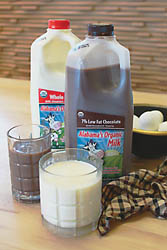 Alabama’s Working Cows Dairy makes pasture raised, organic milk.
Alabama’s Working Cows Dairy makes pasture raised, organic milk.
By Jan Walsh
Photography by Robin Colter
Cream rises to the top. And Working Farms Dairy is “the cream” of Alabama dairies.
Working Cows Dairy’s history begins in 1985, when Jan and Rinske de Jong came to the land of opportunity, from Holland, with $5,000 and a dream to start their own dairy. They traded milking a farmer’s cows for use of his barn and 40 acres in Cottondale, Florida. They then leased 55 cows and started milking 20 hours a day. Three sons: Jonny, Mendy, and Ike and 30 years later the family are the proud owners of Alabama’s only organic dairy, located in Slocomb.
Got organic milk? Think about what the cows eat. If they eat Genetically Modified Organims (GMOs), and you consume their dairy or meat, then so do you. “Although bottling milk is nothing new, sticking to virtues is what many have lost,” Jonny de Jong says. “Industrialization has made many conform to the system with confinement operations and over processing.” Studies have shown that compared to conventional milk, pasture raised, whole milk is higher in omega-3 and in CLAs, Conjugated Linoleic Acids, both of which are associated with a wide variety of health benefits. At Working Cows Dairy the milk is also low temperature pasteurized, which kills the bad bacteria and keeps the good. And it is never homogenized. So shake the jug because cream naturally rises.
When I was a child, organic milk was not hard to find. I would walk to the barn with my grandmother to milk Miss Bess, the cow, each morning. And I have never forgotten the taste of that milk, cream, and the butter—made in a churn. So I am quite the dairy snob—and quite the activist when it comes to animal welfare and factory farms. At Working Cows dairy, they call the cows, “ladies” and many by name. The names are based on their individual personalities. The 250 “ladies” (including all five breeds of dairy cows: Holstein, Ayrshire, Jersey, Brown Swiss and Guernsey) live the opposite life of cows at factory farms. They have plenty of room to graze and run free—approximately 500 acres. And they are not fed supplemental grains—ever. All the cows eat is grass, hay or haylage, which is organically grown from non-GMO grass. And because they eat no grains their milks are naturally gluten free.
Cows that are not stressed produce more and better tasting milk. And these are happy “ladies.” A day in the life of a cow at this dairy begins with a morning of laying in the field or on her waterbed. When it is time for the morning milking, she walks to the milking barn and gets a shower. Next she hops on the merry go round milking parlor, which holds 48 cows at a time. Then it is back to the field with all the other ladies to graze. On extremely hot days, she might stay in the barn and chill on the waterbed being cooled by fans and sprinklers. And she starts the cycle over again for the afternoon milking.
Working Cows Dairy’s milk products are available in a variety of packaging options and milk fat contents including whole, two percent, one percent, skim, chocolate, and heavy cream. The heavy whipping cream is the purest I have tasted since my childhood. And their chocolate milk is deep, dark in color and chocolate flavors—the best ever. And their white milks are just as beautiful and delicious. You can find them locally at Fresh Market, Organic Harvest, Octane Coffee, Piggly Wiggly, Western Supermarkets, Whole Foods, and McEnally’s Mercantile.
Published,
B-Metro magazine, March 2015